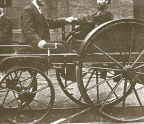“FOR GOD’S SAKE BE DONE WITH RAILWAYS AND SHARES”

There was an article in Backtrack 33/6 (June 2019) about fraudulent promotion of shares in the Mersey Railway and it has to be said that this was not a new phenomenon for the earlier ‘Railway Mania’ had produced a fair crop of both fraudulent and incompetent schemes. In 1711 the South Sea Company was formed as a public private partnership with powers for a monopoly of trade between Britain and South America – this was in return for a loan of £7 million to finance an ongoing war with France, the company agreeing to underwrite the whole of the English National Debt. In doing so it was under the belief that the Government would pay it interest of 5%. Once this became known it led to wild speculation with shares rising to ten times their previous value and the launch of all sorts of companies, easy money being the basic idea. Some of these were completely ridiculous, others were optimistic while others were blatantly fraudulent. Of the ridiculous ones perhaps the daftest was a company to build a gun which would fire square cannonballs, while another wanted to promote an undertaking of great advantage but nobody was to know what it actually was. Almost unbelievably this managed to raise £2,000. Who needs social media and the Internet?
After the fuss over this had died down, all seemed to be going well for some years and the passing of the Bubble Act on 11th June 1720 forbade the formation of joint stock companies unless approved by Royal Charter. There has been much speculation since then about the reasons for this and the latest suggestions have been that the company wanted to prevent competition for investors’ capital. However, all good things come to an end and in the case of the South Sea Company it came later that year when the bubble burst and the value (or perhaps more accurately price) of stocks and shares crashed, with thousands of gullible folk who had made unwise investments losing everything and becoming destitute. Riots ensued and the directors of the company were arrested; no fewer than 462 Members of Parliaments and 112 peers were found to have been subscribers. Eventually the Chancellor of the Exchequer was expelled from Parliament in 1721 along with several other MPs. Even the King, George I, and two of his mistresses were involved and were blamed by many as being responsible for the crash. The whole mess was eventually resolved when Robert Walpole was appointed as Chancellor.
The Queen Victoria effect
Fast forward now by about 120 years and we find that by about 1840 a basic railway network had been built and there was a belief in the country that there was no need for any further expansion; anyway, most people had no need to travel away from their own community at that time. Indeed some folk still looked on passenger railways as akin to the Devil’s work and it was not until 1842, when Queen Victoria made her first rail journey, that this attitude changed. The middle class was beginning to find itself with money to spend as a result of the creation of coal mines and manufactories and suddenly railways became fashionable and speculation began to arise once more, this time in railway stock with investors being lured by promises of huge dividends. Typical promises with the launch of each railway scheme were returns of 10%. Schemes were started
You’re reading a preview, subscribe to read more.
Start your free 30 days



